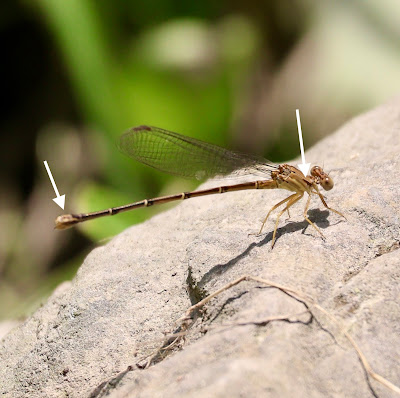I've been photographing dragonflies and damselflies for some years. My interest began in an opportunistic way, usually when out looking for birds. When I saw this beautiful dragonfly perched on a stem on June 12, 2015, I had no idea what it was and didn't find out until 2023! I have often admitted to being a poor archivist of my photos and, by accident, came across this photo again and pursued the ID.
Four-spotted Skimmer (Libellula quadrimaculata), Upper Peninsula, Michigan
This remains the only Four-spotted Skimmer I have ever seen, but my interest in Odonata has increased and my knowledge base has improved slowly since 2015. Not just in identification, which some would argue remains poor, but in other areas of recognition as well.
Still, because of the judgment from others that comes with being a novice, I am often reluctant to draw attention to some observations that have intrigued me. Whether identifying an odonate, a bird or a bumblebee incorrectly, no one likes being treated dismissively. I love learning so I press on and try to ignore the noise.
Today while perusing some odonate websites, articles and literature I found this blog post: Physiological Color Change in Argia Apicalis, by Dr. Amanda Whispell of Rutgers University (PhD); I believe she now lives in Virginia. I recalled the Blue-fronted Dancers (Argia apicalis) I found in early July (2024) at Lower Huron Metropark in Michigan. When it came time to enter my location list into Odonata Central (OC), I held back on entering an unexpected sighting and stuck with the more typical-appearing Blue-fronted Dancer for the OC photo entry.
All of my photos below are of Blue-fronted Dancers seen on the same day, in the same area and around the same time generally.
But it was the Blue-fronted Dancer in the photo below that intrigued me. A green thorax on a Blue-fronted Dancer?
Other references:
1. In addition to Dennis Paulsen's well-known Dragonflies and Damselflies of the East, 2011, Princeton University Press, I also use Damselflies of Minnesota, Wisconsin & Michigan by Robert DuBois with photos by Mike Reese. Remarkably the DuBois book can be purchased at Target which I have linked above. It is also on the Kollath & Stensaas Publishing website. (An earlier edition titled Damselflies of the North Woods covering 44 species is purple. Don't buy that one,)
2. For this piece I also used the brand new A Naturalist's Guide to the Odonata of Ohio, by Dave McShaffrey, Malisa Spring and Jim McCormac, Ohio Biologic Survey, 2024. The photographs of A. apicalis on page 88 are large and clear. Describing female Argia apicalis the authors write: "Females are trickier to recognize." They go on to describe blue and brown morphs, but make no mention of a green morph. They also write: Blue forms of both sexes can noticeably darken the thorax from light blue to dark gray. Many observers notice this darkening when the dancers are in tandem; however, a published study did not find such a correlation." I recommend this guide for the excellent and large photos, but also for the extensive, clear and very well-written species descriptions. I try to avoid linking any book to Amazon, but unfortunately this book is quite expensive on the publisher's website. It will be cheaper purchased elsewhere.
3. I found this excellent website, Delmarva Dragonflies and Damselflies by Mike Moore. which I keep going back to over and over, sometimes just to look at the photos, but also to use for identification assistance. I used to live in Baltimore and was a frequent visitor to Maryland's Eastern Shore. In the summer of 2018 I returned and, along with friends, rented a house on the Chesapeake Bay in Talbot County. Finding and photographing odonata species new to me made it an extremely enjoyable vacation. Mike Moore is an Odonata Central Admin reviewer and helped with several of my Talbot county submissions. He also recently helped me with some of my Midwest submissions.
No photo guide or website is going to be 100% useful for making identifications. The experts will tell you that, when in doubt, you need to net the odonate and use a magnifier. True enough, but easier said than done - at least for me. I recently caught two red meadowhawks by hand and took poor photos of the gentalia with my iPhone 14. I still could not make the field marks match an ID with confidence. The only thing to do is continue trying and learning.
All comments are welcome, but comments with corrections are especially welcome!










1 comment:
There is a quick(er) way to determine the sex of odonates without even having to know the species. In a lateral view, look underneath abdominal sections 2 and 3. The male has secondary genitalia there -- you'll nearly always be able to see some structures protruding from these sections. Females have no opening or structures there and the underside of those sections will appear smooth. Getting to know what the basic appearance of the terminal appendages of various families is also helpful for quickly determining sex.
Post a Comment